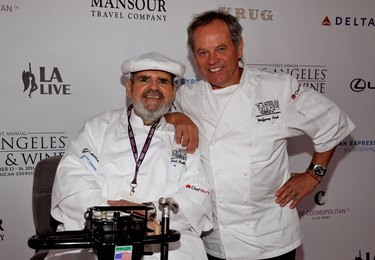
The prevailing idea behind blackened burgers is "go big" -- high heat, hearty meat and heavy seasonings. Blackening is more than a thick coating of pungent spices and butter -- it's also a technique. The requisite crust forms on a blackened burger when you lay it in a screaming-hot pan and slide it under the broiler. The butter blackens to near burning, or pyrolizes, and essentially bakes the spices into the meat. You need a cast-iron skillet or grill pan to blacken. This technique creates a lot of smoke of the turn-on-the-fan-and-open-the-window variety. If your kitchen doesn't have adequate ventilation, go with pan-frying or grilling instead.
Prudhomme's Blackened Spice
Video of the Day
Make your own blackened spice using the proportions Chef Paul Prudhomme made famous -- store brands almost always include sodium, which limits your control over the overall saltiness of the preparation.
Video of the Day
In a mixing bowl, combine 1 tablespoon of paprika; 1 teaspoon each onion powder, garlic powder and cayenne pepper; 3/4 teaspoon each white and black pepper; 1/2 teaspoon each oregano and thyme; and 2 1/2 teaspoons of kosher salt.
Whisk the blackened spices until they appear uniformly dispersed, about 2 minutes of total mixing time. Pour the blackened spice into a shallow dish and set it aside.
Forming the Burgers
Keeping ground beef cold is paramount to keeping the burgers safe to eat. If you have to delay cooking the burgers after you form them, keep them in the refrigerator. Hold the ground beef in a stainless-steel bowl placed over another bowl half full of ice to keep it below 40 degrees Fahrenheit while you make the patties.
Break up 1 pound of ground beef by hand. Separate the ground beef into two portions of the approximate size for 8-ounce burgers. Gently roll each portion into a cohesive ball -- don't use much pressure, as the beef will coalesce after about 30 seconds of rolling.
Next, place the ball of ground beef on a plate and gently press it with the underside of a saucer until it's about 3/4 inches tall. You need a flat surface on both sides of the burger for an even crust. Place the burgers on a plate and set them aside in the refrigerator.
Complementary Sauces
Before you fire the hamburgers, have a complementary sauce ready to go. Although optional, mayonnaise-based sauces work best with blackened burgers; they temper the spiciness of the seasoning and offset its pungency. The Cajun classic remoulade pairs seamlessly with blackened burgers, but you can make your own mayonnaise-based sauce by following the fundamental sauce-making method.
Add mayonnaise to a mixing bowl and a primary flavoring ingredient, such as minced garlic or shallots. Next, add a secondary flavoring -- fresh herbs, such as thyme and parsley, fit best here. Stir in a touch of acid, such as lemon juice or flavored vinegar, to "cut" the fattiness of the mayo, and adjust the seasoning as needed with kosher salt and freshly ground black pepper.
Setting Up for Cooking
Set the oven rack 4 to 5 inches below the broiler and let it heat for 15 to 20 minutes.
Melt a few tablespoons of butter in a saucepan and pour it on a rimmed plate. Dip both sides of each hamburger patty in the butter and lay it in the shallow dish of seasoning. Gently press the patty into the spices, then turn it over and repeat. Set the hamburgers on a plate as you season them.
Showtime
Turn on your range hood to the highest ventilation setting. Wipe the cast-iron pan with a paper towel to rid it of as much residual oil as possible; this prevents excessive smoking. Set the pan on the stove over high heat; this all but guarantees a thick, crisp blackened crust. After the pan heats for 8 to 10 minutes, pull the oven rack out halfway and place the pan on it.
Lay the burgers in the pan, slide the rack into the oven and close the door. Turn the burgers over after 4 minutes of cooking and broil them for an additional 4 minutes. Use an instant-read thermometer to check each burger for an internal temperature of 165 F.